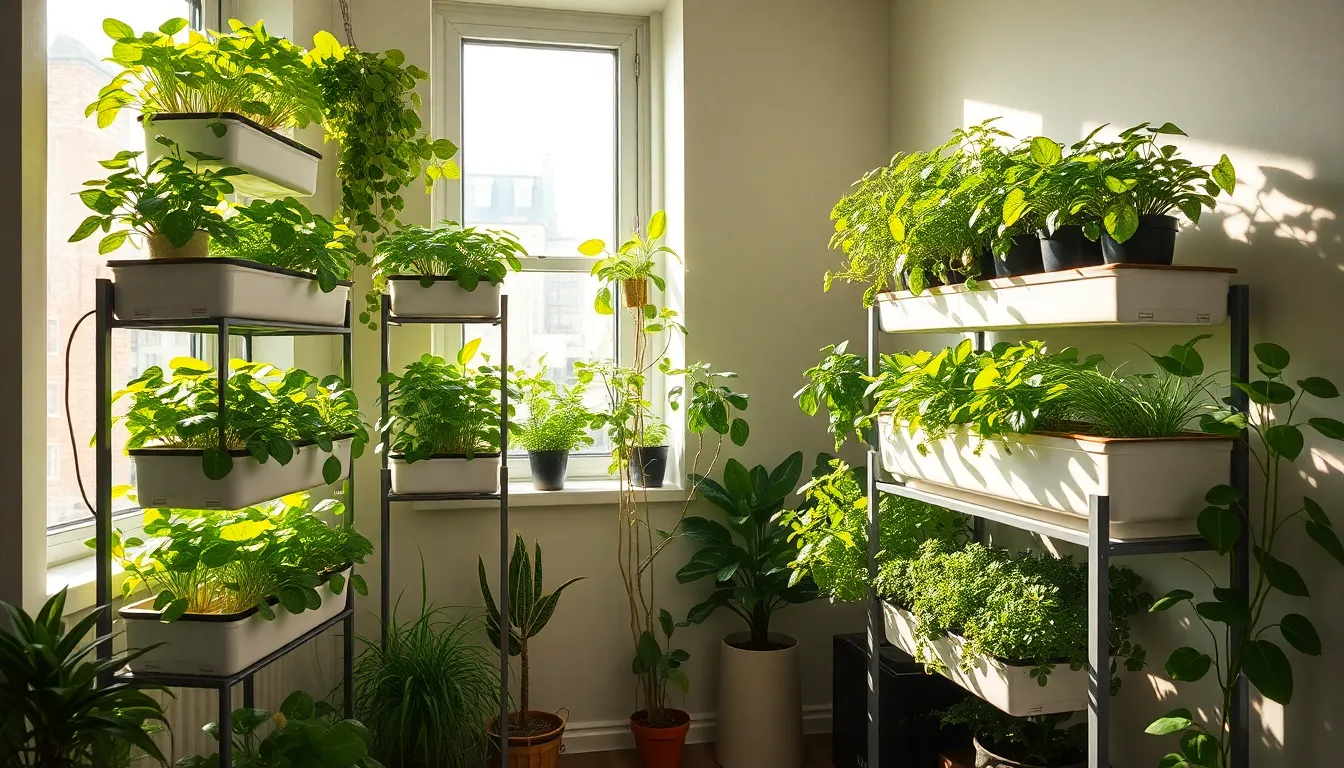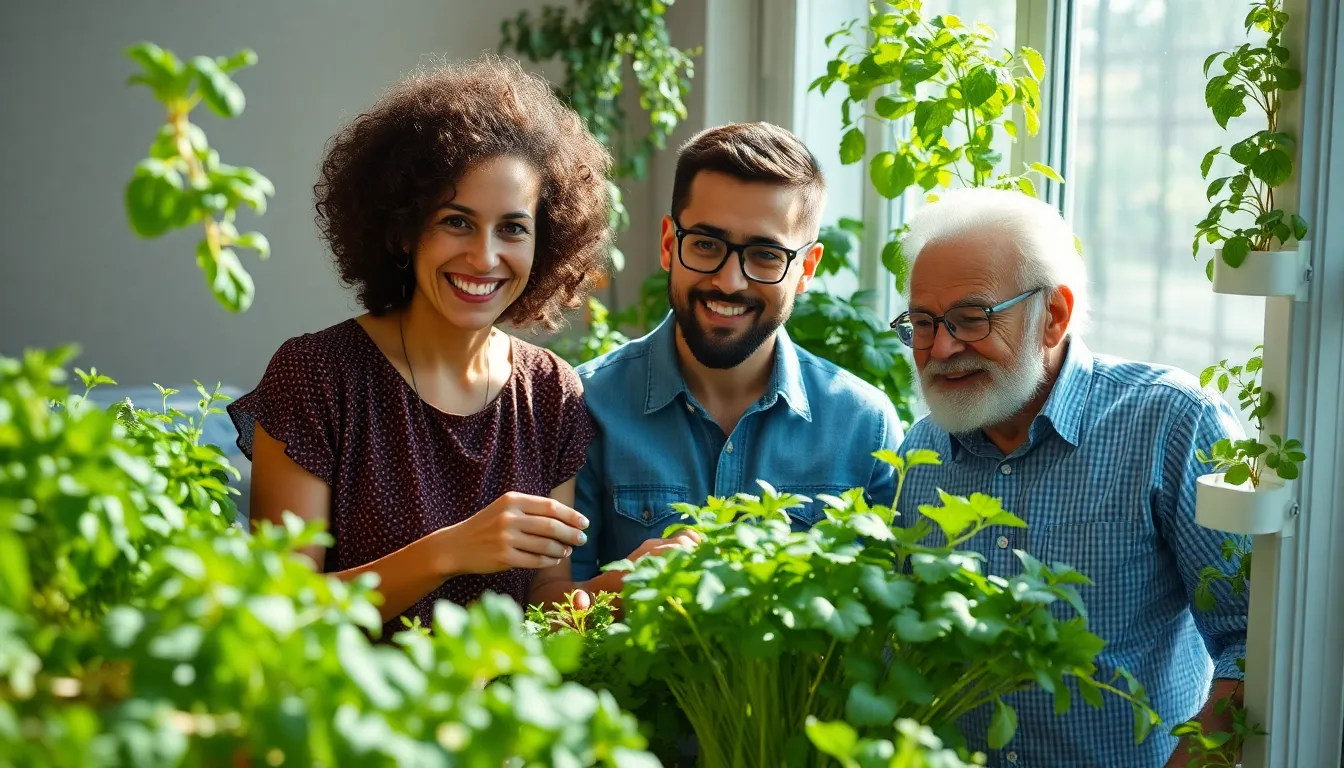Imagine growing fresh herbs and veggies right in your living room without the mess of soil. Sounds like magic? Welcome to the world of hydroponic gardening! This innovative system allows anyone, from seasoned green thumbs to those who can barely keep a cactus alive, to cultivate plants with ease.
Table of Contents
ToggleOverview of Hydroponic Gardening System
Hydroponic gardening eliminates the need for soil, allowing plants to grow in nutrient-rich water. This method offers several advantages, including faster growth rates and higher yield potential. By providing plants with direct access to essential nutrients, hydroponic systems facilitate healthier and more robust plant development.
Different types of hydroponic systems exist, such as nutrient film technique (NFT), deep water culture (DWC), and aeroponics. NFT involves a thin film of nutrient solution flowing over the plant roots, ensuring adequate oxygenation and nutrient absorption. DWC suspends plants in a nutrient solution, encouraging rapid growth and development. Aeroponics mistes plant roots with nutrient-rich water, enhancing oxygen exposure and facilitating swift growth.
A key benefit of hydroponic gardening is reduced water usage. Compared to traditional soil gardening, hydroponics can use up to 90% less water. Plants absorb only the necessary amount of water, minimizing waste and promoting sustainability.
Indoor settings often serve as ideal environments for hydroponic systems. Controlled conditions allow for year-round growing, regardless of outdoor weather fluctuations. These systems also reduce the likelihood of pests and diseases that typically affect soil-grown crops.
Growing fresh herbs and vegetables in hydroponic setups makes gardening accessible even to those with limited outdoor space. With self-contained systems available for any budget, anyone can successfully cultivate plants indoors.
Hydroponic gardening caters to diverse plant varieties, including leafy greens, herbs, and fruiting plants. Examples include basil, spinach, strawberries, and tomatoes. The versatility of hydroponic systems makes them an attractive option for urban dwellers and gardening enthusiasts alike.
Benefits of Hydroponic Gardening System

Hydroponic gardening presents numerous benefits that enhance plant growth and resource efficiency. This innovative approach to gardening offers advantages appealing to both novices and experts.
Space Efficiency
Hydroponic systems maximize space utilization, making them perfect for small apartments and urban settings. Vertical gardening techniques further optimize limited areas. Different systems fit various spaces, including countertops and balconies. Gardeners grow more produce without needing expansive outdoor areas. This method of gardening allows for the placement of multiple plants close together while maintaining healthy growth conditions. Effective use of shelving and modular units makes it simple to create a productive garden without sacrificing valuable floor space.
Water Conservation
Water conservation stands as one of the most compelling advantages of hydroponic gardening. Hydroponic systems use up to 90% less water than traditional gardening methods. Nutrient-rich solutions recirculate within the system, reducing waste and ensuring every drop counts. Less evaporation occurs in controlled indoor environments, leading to significant water savings. Gardeners enjoy consistent access to water-sourced nutrients without overwatered soil and waterlogged roots. Efficient nutrient management systems cultivate healthier plants while conserving vital resources.
Types of Hydroponic Systems
Various hydroponic systems exist, each tailored to specific growing needs. Understanding these systems enhances gardening success and maximizes yields.
Nutrient Film Technique (NFT)
Nutrient Film Technique uses a thin film of nutrient-rich water flowing over plant roots. This method provides continuous access to nutrients and oxygen, promoting rapid growth. Plants grow in shallow, sloped channels allowing for efficient drainage. NFT systems require careful monitoring to prevent pump failures, which could lead to root drying. Ideal for short-term crops like leafy greens, NFT systems thrive in controlled environments, making them perfect for indoor gardening setups.
Ebb and Flow (Flood and Drain)
Ebb and Flow systems periodically flood the grow bed with nutrient solution and then drain it back into the reservoir. This cycle allows plant roots to absorb nutrients and oxygen while preventing waterlogging. Growers can adjust the flooding frequency based on plant needs. Ebb and Flow systems work well for a wide variety of plants, including larger fruiting varieties. Flexibility remains a key feature, as automated timers can simplify the maintenance process for busy gardeners.
Essential Components
Essential components form the backbone of an effective hydroponic gardening system. Understanding these elements helps ensure successful plant growth.
Growth Medium
Growth mediums in hydroponics serve as a support system for plants. Common options include rock wool, coconut coir, and clay pellets. These mediums retain moisture while allowing air circulation, promoting healthy root development. Rock wool offers excellent water retention and accessibility for roots. Coconut coir provides a sustainable alternative, supporting moisture without becoming too dense. Clay pellets encourage drainage while being reusable, making them a favorite among gardeners. Each medium holds unique properties, so choosing the right one can significantly impact plant health and yield.
Nutrient Solutions
Nutrient solutions contain vital elements for plant growth, including macronutrients and micronutrients. Key macronutrients, such as nitrogen, phosphorus, and potassium, play fundamental roles in plant development. Micronutrients like calcium, magnesium, and iron support various physiological functions. Commercially available nutrient solutions simplify the process, providing balanced formulations specifically designed for hydroponics. Mixing solutions according to manufacturer recommendations ensures essential nutrients are readily available to plants. Additionally, monitoring pH and electrical conductivity helps maintain optimal nutrient absorption, boosting growth rates and improving yields.
Maintenance and Care
Maintaining a hydroponic gardening system ensures optimal plant growth and healthy yields. Regular care involves monitoring essential components like pH levels and light conditions.
Monitoring pH Levels
pH levels directly affect nutrient availability for plants. Maintaining pH in the range of 5.5 to 6.5 provides optimal nutrient absorption. Regular testing of nutrient solutions with pH meters or strips enables quick detection of fluctuations. Adjustments using pH up or pH down solutions help restore balance. Monitoring should occur at least once a week or more frequently during growth spurts. Neglecting pH management can lead to nutrient deficiencies or toxicities, impacting plant health.
Managing Light Conditions
Light conditions play a vital role in plant growth within hydroponic systems. Using grow lights with spectrums suited for the growth stage significantly enhances photosynthesis. Positioning lights at an appropriate distance prevents overheating while ensuring adequate coverage. Ideal light duration ranges between 12 to 18 hours, depending on the plant type. Regularly checking light intensity and adjusting based on plant response helps optimize growth. Failure to manage light conditions can result in leggy plants or poor yields.
Hydroponic gardening represents a revolutionary approach to cultivating plants without soil. This method not only maximizes space and conserves water but also allows for year-round growth in various environments. With a range of systems available, gardeners can choose one that best fits their needs and preferences.
The focus on nutrient-rich solutions and careful monitoring ensures healthy plants and impressive yields. As urban living continues to rise, hydroponics offers a sustainable solution for fresh produce. Embracing this innovative gardening technique can lead to a rewarding and productive experience for both novice and seasoned gardeners.




